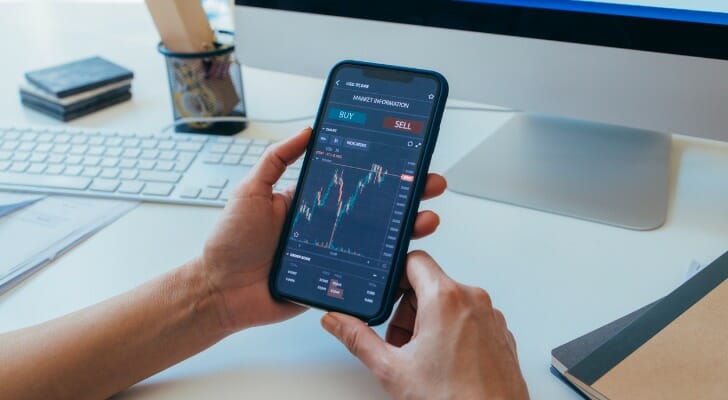The value of individual cryptocurrencies can swing widely in the span of days or even hours. That volatility makes it difficult for investors to manage such assets and difficult for them to conduct cryptocurrency-based transactions. Stablecoins aim to solve this problem by creating cryptocurrencies that are pegged to the value of another asset. These assets, in theory, have a set, stable value for each stablecoin that investors can rely on. Unless you’re well versed in crypto, it can be helpful to speak with a financial advisor before choosing to invest in any of the coins.
What Are Stablecoins?
A stablecoin is a type of currency that has its value defined by, or “pegged to,” an external asset like the price of gold, other cryptocurrencies or fiat currencies. While a stablecoin can define its value by any external asset most, if not all, major projects use the U.S. dollar. That typically makes the coin’s value $1 per coin. Stablecoins include some of the biggest assets on the market such as Tether and Binance.
This is not a practice unique to cryptocurrencies. Globally, countries that struggle with currency instability or that want to ensure the strength of their export and services sectors will sometimes fix their currencies to that of a larger economy. For example, at the time of writing the Hong Kong dollar was fixed at 7.76 to $1 U.S. This gives the economy predictability on the world stage. Investors can buy into the local economy confident that their money will keep its value.
The purpose of a stablecoin is to give cryptocurrency investors a similarly useful tool for spending and exchange. The hope is that these stablecoins can provide longevity and acceptability in the ability for consumers to predict and depend on the value of some crypto.
Problems With Stablecoins
One of the biggest problems with cryptocurrency is its volatility. Asset prices can swing widely, sometimes in as little as a few hours. This creates a few major problems, such as:
- Spending – It is difficult, if not impossible, to spend an asset with this kind of volatility. The fact that cryptocurrency can gain value so rapidly encourages people to hold on to it rather than spend it. Why buy a cup of coffee today when tomorrow you might get a car? On the other hand, the fact that it can lose value so rapidly encourages people to get rid of it.
- Investing – The fear and greed cycle of investing is magnified by cryptocurrency’s volatility. This makes it a very speculative investment that’s difficult to plan around and requires a bit of expertise in the area in order to predict its impact on your portfolio.
- Transactions – Many cryptocurrencies and exchanges don’t accept fiat currency like the U.S. dollar. They require you to buy and sell assets with other cryptocurrencies. However, as with consumer spending, the extreme volatility makes it difficult to transact business with other cryptocurrencies.
In theory, stablecoins are the solution to these problems. By having a fixed value, you can always know what your stablecoins are worth. They are intended as a utility asset more than an investment. You can use stablecoins to buy and sell other cryptocurrencies, managing your investments with a reliable asset that won’t jump around in value.
How Do Stablecoins Work?

To make a stablecoin you need to guarantee both the bid and the ask price for the asset. For example, say that you would like to make a stablecoin set at $1. You would need to guarantee that anyone who wants to sell your stablecoin can do so for no less than $1 U.S. You would also need to guarantee that anyone who wants to buy your stablecoin never has to pay more than $1.
This is accomplished in two ways: The algorithmic model and collateralized pricing.
1. Algorithmic Model
In theory, the easy way to fix a stablecoin’s price is through the algorithmic model. By easy we mean it only takes lines of code rather than hundreds of millions of dollars.
In this model, you control the price of your stablecoin by controlling the supply on the market. If the price goes too high, your algorithm automatically creates and releases new tokens into the market. This increases the number of coins in circulation, reducing the price. If the price goes too low, your algorithm will reduce (or “burn”) the number of coins in circulation. This increases scarcity, which raises the price. There are two potential problems with this.
First, it’s almost impossible to get an algorithm like this right. No one knows exactly how any given market will react to supply and demand shocks, so there’s no way of knowing in advance how many coins you need to add or subtract in order to get your prices back to a fixed point. Instead, you create an arbitrage pool where investors know in advance how your asset supply will change based on its price and can game the system accordingly.
Second, how exactly do you remove those coins from circulation? Since the problem is the price of coins on the open market they belong to third parties. One option is to have your algorithm directly delete those assets from investors’ wallets. This is a sophisticated technical approach known in layman’s terms as a “class A felony.”
2. Collateralized Pricing
The other option for fixing a stablecoin’s price is by holding cash in reserve. This is known as collateralized pricing, or market-making. It is how governments traditionally peg their currencies to an external currency.
In this model, you serve as a buyer and a seller of last resort. If the price of your stablecoin goes too high, you guarantee that you will always create and sell new coins at the fixed price. For example, if the market price of your stablecoin increased to $1.05, you would always offer to sell individual coins for $1. This would undercut the rest of the market since anyone who wants to buy your stablecoin can get it from you for $1.
At the same time, if the price of your stablecoin falls too low then you guarantee that you will always buy existing coins at a fixed price. For example, if the market price of your stablecoin falls to $0.95, you would always offer to buy individual coins for $1 each. Once again, this would undercut the rest of the market, since nobody who wants to sell has to accept less than the $1 you’re offering.
This model works perfectly well if you have the reserves to back it up. However, it is costly since you need to literally have $1 in the bank for every coin you put into circulation. This puts stablecoin projects in something of a Catch-22. They make their money by selling their initial set of tokens for $1 per coin. If they put that money in the bank, then they have the collateral to back up their project but no operating revenue. If they treat that money as revenue, then they have operating funds and profits but no collateral.
While collateralized stablecoins like Tether have seen more success than algorithmic models like TerraUSD, they are rare. Just as importantly, many government regulators suspect that major collateralized stablecoins may have defrauded investors and don’t actually have the assets they claim.
Bottom Line

Stablecoins are cryptocurrencies that have their value defined by some external asset. In most cases, the stablecoin project will set its value at $1 per coin and will then manage its cryptocurrency to maintain that price. However, these projects are still volatile and are not as stable as similar behaviors throughout the world. Crypto would need to be more widely accepted and collateralized through some form of regulation before a stablecoin can fulfill its full role.
Tips for Investing In Crypto
- Crypto is not something that anyone can just dive into and figure out how to make loads of cash overnight. It takes time, patience and a strong understanding of how it works. If you’re just starting out you can speak to a financial advisor who can find a way to help make crypto part of your overall financial plan. Finding a qualified financial advisor doesn’t have to be hard. SmartAsset’s free tool matches you with up to three financial advisors who serve your area, and you can interview your advisor matches at no cost to decide which one is right for you. If you’re ready to find an advisor who can help you achieve your financial goals, get started now.
- If you’re interested in cryptocurrency but lack experience, you can start by reading our guide on what exactly blockchain is.
Photo credit: ©iStock.com/Peopleimages, ©iStock.com/Iakshmiprasad S, ©iStock.com/FreshSplash
